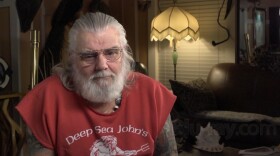If you’re a resident killer whale, Puget Sound can be a busy, noisy place. During the summer tourist season - when orcas come into the Sound regularly - they can be surrounded by more than 20 boats. New research out this week shows the speed of those boats is a critical factor in how much noise they make, underwater.
Earthfix reporter Ashley Ahearn sent this report. It starts with a trip she made a few years ago, with scientists studying orcas and underwater noise.
We get word that the whales are nearby soon after leaving the dock at Friday Harbor Labs on San Juan Island.
Brad Hanson (on radio): “Yeah we just got a report that the whales are in Bellingham Channel.”
“Alright, thanks.”
Brad Hanson is an expert on orcas with the National Oceanic and Atmospheric Administration in Seattle.
Brad Hanson: “Ok, we’re going to run over there.”
The zodiac takes off, packed with gear and scientists. Their mission is a tricky one. They’re going to try and attach a high tech data collection device to a moving orca.
It’s called a Dtag and it’s about the size of your hand. One side’s lined with small suction cups that will stick onto the whale’s back.
Once it’s attached the Dtag will track the movement of the whale through the water. The goal is to learn more about how all the boats travelling through Puget Sound might be affecting orca behavior. Are they foraging less? Are they socializing less?
We come around Lopez Island heading to Rosario Strait and there are orcas all around us. The research vessel slows way down as the team gets ready.
Now comes the easy part. All they have to do is get the tiny Dtag stuck to the back of a 5-ton whale - a whale that’s moving rapidly through the water on the hunt for salmon.
Jeff Hogan is the lucky guy in charge of that part of the operation. He’s standing in the bow of the boat holding a long pole with the Dtag attached to the end. The whales are just meters away.
Jeff Hogan: Underwater here at a our 4 at 20.
Hogan will reach out with the pole and place the suction device on to the whale’s back. His set up is harmless, but effective.
The team has picked out a large adult male they identify as L84. Suddenly he surfaces right next to the boat and Jeff Hogan seizes his moment.
Jeff Hogan: Ok, here we come up right here. (Breathes)
Tag’s on. He’s back over here. He’s at our 11. 10 and 11.
The tag sticks and L84 goes right back to hunting for salmon, as Deborah Giles steps up to the bow. She’s an expert on orca behavior and vessel interaction.
Giles is holding a device on a tripod that looks like something a land surveyor uses on construction sites. It’s called a laser range finder.
She’s aiming it at the place where L84 last surfaced, waiting for him to come up again.
Deb Giles: “Basically what I’m recording is where the whale is on the planet, and that allows me to with this equipment to get distances from whales to boats.”
Ok, so that scene you just heard was recorded in 2012. But this team is still studying orcas.
They want to better understand how boats contribute to underwater noise.
And that’s important because there are more boats following these whales around every year. The number of commercial whale watching boats in Washington and British Columbia has quadrupled since the 80s.
The scientists attached dtags to more than 20 orcas over the past few years and gathered underwater recordings - to see how noisy it is from the whale’s perspective. Juliana Houghton: So at first it just sounds like a steady engine noise and then you hear the tic tic tic. It’s actually the propeller of a ferry passing.
Juliana Houghton analyzed the recordings for her masters at the University of Washington School of Fisheries. Her research was just published in the journal PLOS One.
She took the volume levels in the recordings and lined them up with the numbers of boats that were nearby at the time. She also recorded the size of the boats, how many propellers they had, and the speed they were traveling. The goal: find out which factors make the most underwater noise.
Juliana Houghton: "Of all the characteristics that we examined, vessel speed was the most important factor for how loud it was for the whales."
So, Houghton says, the best thing we can do for endangered orcas is: slow down.
Federal regulations require that boats stay 200 yards away from orcas in the wild, but boaters aren’t subject to any specific speed limits when whales are nearby.
The National Oceanic and Atmospheric Administration says it will consider whether to recommend speed limit regulations near orcas next year.





